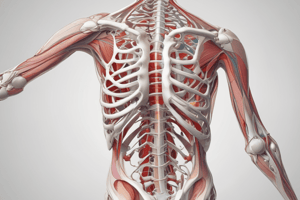Podcast
Questions and Answers
What is the primary function of the skeletal system?
What is the primary function of the skeletal system?
- To maintain posture and balance
- To provide structural support and protection (correct)
- To regulate body temperature
- To facilitate movement
What connects muscles to bones?
What connects muscles to bones?
- Ligaments
- Tendons (correct)
- Muscle fibers
- Joints
Which type of muscle controls involuntary movements?
Which type of muscle controls involuntary movements?
- Skeletal muscles
- Tendon muscles
- Smooth muscles (correct)
- Cardiac muscles
What provides stability to joints?
What provides stability to joints?
How many bones are in the adult human skeletal system?
How many bones are in the adult human skeletal system?
Flashcards are hidden until you start studying
Study Notes
Musculoskeletal System Overview
The musculoskeletal system is a complex system that provides support, stability, and movement to the body.
Functions
- Support: Provides framework for the body, allowing it to maintain its shape and protect internal organs
- Stability: Enables the body to maintain its posture and balance
- Movement: Facilitates movement of the body through the contraction and relaxation of muscles
Components
- Skeletal System: 206 bones that provide structural support and protection
- Muscular System: Over 600 muscles that facilitate movement and maintain posture
- Tendons: Connect muscles to bones, enabling movement
- Ligaments: Connect bones to bones, providing stability to joints
- Joints: Allow for movement and flexibility between bones
Types of Muscles
- Skeletal Muscles: Voluntary muscles that control movement and posture
- Smooth Muscles: Involuntary muscles that control involuntary movements (e.g. digestion)
- Cardiac Muscles: Involuntary muscles that control heart contractions
Muscle Actions
- Flexion: Movement that decreases the angle between two bones
- Extension: Movement that increases the angle between two bones
- Abduction: Movement away from the midline of the body
- Adduction: Movement towards the midline of the body
- Rotation: Movement around a central axis
Common Musculoskeletal Disorders
- Osteoarthritis: Wear and tear on joints, leading to pain and stiffness
- Rheumatoid Arthritis: Autoimmune disorder that causes inflammation and pain in joints
- Muscle Strains: Tears or pulls in muscles, leading to pain and weakness
- Tendinitis: Inflammation of tendons, leading to pain and stiffness
Musculoskeletal System Overview
- Provides support, stability, and movement to the body through its framework and muscles
Functions
- Provides framework for the body, allowing it to maintain its shape and protect internal organs
- Enables the body to maintain its posture and balance
- Facilitates movement of the body through muscle contraction and relaxation
Components
- Skeletal System: 206 bones providing structural support and protection
- Muscular System: Over 600 muscles facilitating movement and maintaining posture
- Tendons: Connect muscles to bones, enabling movement
- Ligaments: Connect bones to bones, providing stability to joints
- Joints: Allow for movement and flexibility between bones
Types of Muscles
- Skeletal Muscles: Voluntary muscles controlling movement and posture
- Smooth Muscles: Involuntary muscles controlling involuntary movements (e.g. digestion)
- Cardiac Muscles: Involuntary muscles controlling heart contractions
Muscle Actions
- Flexion: Decreases the angle between two bones
- Extension: Increases the angle between two bones
- Abduction: Movement away from the midline of the body
- Adduction: Movement towards the midline of the body
- Rotation: Movement around a central axis
Common Musculoskeletal Disorders
- Osteoarthritis: Wear and tear on joints, causing pain and stiffness
- Rheumatoid Arthritis: Autoimmune disorder causing inflammation and pain in joints
- Muscle Strains: Tears or pulls in muscles, leading to pain and weakness
- Tendinitis: Inflammation of tendons, leading to pain and stiffness
Studying That Suits You
Use AI to generate personalized quizzes and flashcards to suit your learning preferences.





